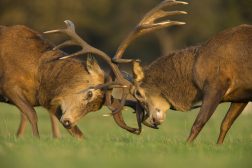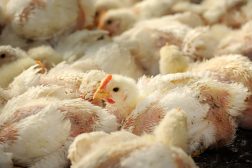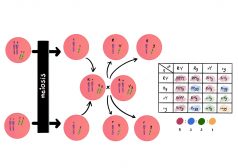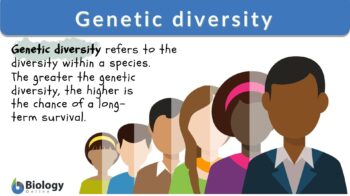
Genetic diversity
n., plural: genetic diversities
[d͡ʒɪˈnɛtɪk daɪˈvɜːsɪtɪ]
Definition: allelic diversity, such as within a species
Table of Contents
Genetic Diversity Definition
Each species is composed of individuals with their own set of genes. A gene is the inheritance unit by which generations can inherit the features of their parents. It refers to the nucleotide sequence in the DNA strands packaged in chromosomes. These genes are responsible for the expression of their distinct features since these genes control the differences and similar characteristics among different organisms. A population would have different genes that are responsible for the variation among its members. For example, the population of humans consists of individuals with different physical traits reflecting their genetic diversity. Apart from between species, genetic diversity may also be observed among species. For instance, the population of dogs may consist of different breeds of dogs.
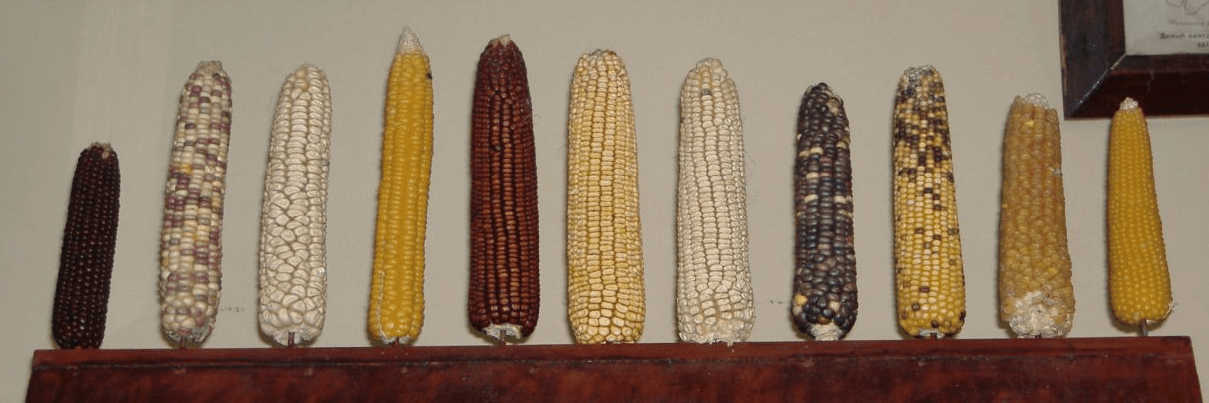
Genetic diversity, variability, and variation
To further understand genetic diversity, let us define related terms. Genetic variability is defined as the tendency of a population to produce organisms with different genotypes. How about genetic variation? What is it? Genetic variation is defined as the presence of a various number of alleles with different distribution frequencies in a certain population. Genetic variation simply refers to the variation of genomes at the individual level (i.e., between individuals) or at the species level (i.e. between species populations). The variation may result from a mutation; mutations may cause the emergence of mutants or variants. Apart from mutation, other mechanisms leading to genetic variation are sexual reproduction and genetic drift. Conversely, the term “genetic diversity” expresses the total number of variations.
Genetic diversity and biodiversity
What is the impact of genetic diversity on biodiversity? Genetic diversity is the main contributor to biodiversity in an ecosystem. The term biodiversity refers to the biological diversity of life on Earth and therefore that includes multifarious microorganisms, plants, and animals along with their genes and their respective environments or habitats.
Many researchers define genetic diversity as the amount and extent of genetic variability among populations whereas biodiversity refers to the diversity of all organisms in a given ecosystem at a given time.
Other terms that are relevant to this topic include “ecosystem diversity” and “species diversity”. Ecosystem diversity refers to the presence of different ecosystems in a certain place; species diversity is defined as the presence of different species in a given region. All differences within species originate from the diversity of their genes. The diversity of species is a fundamental aspect of a healthy ecosystem. The extent of these diversities is engendered by genetic diversity. Species with a higher diversity have a lower tendency to become extinct. The greater the genetic diversity within a species, the greater is the chance of that species to survive. Conversely, the lower the genetic diversity within a species, the lower is the chance of survival. This is because unfavorable traits, such as inherited diseases, may become widespread within a population. When left to reproduce, there is a high tendency that the offspring will similarly express the unfavorable trait because of the high chance of inheriting the gene causing it due to a low diverse gene pool.
Apart from genetic diversity, another source of diversity within species or within a population is the environment. The interaction of the environment and genes are responsible for the extent of diversities among individuals in a population.
A population may consist of a small or a large number of individuals. Some of these individuals may mate and produce offspring. The extent of genetic variation among individuals is variable. Genetic diversity is present within a population because individuals have different genes due to slight differences in their DNA sequences. Alteration in DNA sequences due to mutations can produce different alleles. Variation in alleles affects the adaptability of the organism, its physiological development, and its ability to survive and reproduce in different environmental conditions.
Importance of Genetic Diversity
Why is genetic diversity important? Genetic diversity is important because it could ensure that certain groups of individuals, species, or populations will be able to adapt to certain environmental factors. Besides having to deal with environmental conditions, genetic diversity renders them the ability to resist emerging diseases and epidemics. On the contrary, low genetic diversity may increase the susceptibility of a species to biotic and abiotic stresses such as diseases and drought, and therefore, facing a higher risk of extinction in the long run.
Why is genetic variation important? As mentioned, genetic diversity is engendered by genetic variation. Genetic variation is essential for a species, in particular, because it allows them to adapt to different environmental conditions. As a result, the species is less likely to become extinct and therefore survive for a long time. Thus, genetic variation helps the species in terms of its adaptability, survival, and its evolution.
Now, why is a diverse gene pool important? The diversity of the gene pool enables the species to survive because the more variegated the genes are within a population, the more diverse the alleles there will be. Among these alleles, there could be certain ones that will enable certain individuals to become better adapted and therefore survive a particular set of environmental stressors. Thus, the next generations will therefore be at an advantage as they could inherit such alleles that will enable them to tolerate certain conditions. This is how it could help maintain the survival of their species.
The ability of species to adapt to the change in environmental conditions determines their long-term survival. This long-term survival depends on the genetic diversity among species. For example, the tolerability of different individuals among the same population to the same stressor differs. Some individuals carrying certain genes can live in a high load of pollutants in their environment while other individuals cannot. Surviving individuals can transfer the genes responsible for resistance to pollutants to their offspring contributing to the future ability of the population to adapt to environmental conditions.
Greater diversity of species leads to higher habitat diversity. Species diversity maintains the functions and structure of ecosystems. Ecosystem diversity enables ecosystems to recover from the effects of any changes occurring due to natural disasters or sudden changes. Low-diversity ecosystems do not easily establish their normal function. Instead, their function might be permanently changed, which changes species composition and leads to a great loss of natural resources.
Genetic diversity provides information on the evolutionary process. It is considered as the raw material and key to evolution as well as the adjustment of species to change the world. Some species may eventually not survive if they fail to evolve and consequently adapt to environmental changes.
Genetic diversity in small populations is important because they can easily lose their genetic diversity over time due to the influence of genetic drift. The fixation and drifting of a certain allele may lead to the loss of another one, leading to loss of genetic diversity over time. When two individuals mate in a small population, they are more likely to have the same allele passing it across generations, which finally leads to the fixation of an allele decreasing the genetic diversity among this population. On the contrary, large populations maintain genetic diversity by keeping their genetic material. That’s why when a population is exposed to the bottleneck effect, they are more likely to lose their genetic diversity than large populations. Therefore, genetic diversity among large mammals is more important than small ones, since they produce a relatively low number of offspring. Conservation genetics is an important consideration to rescue genetic diversity among species exposed to extinction.
What is the biological significance of genetic diversity between populations? The extinction of a certain species is lower if high genetic diversity is present among populations since low rates of genetic diversity decrease the fitness in a population. This decline is one of the factors increasing the risk of extinction.
Finally, genetic diversity is responsible for the morphological, physiological, and behavioral variations among species, populations, and individuals, which consequently affects ecosystem services and ecological functions. Therefore, the decline in genetic diversity among species populations can affect both services of the ecosystem as well as the well-being of humans.
Examples of Genetic Diversity
What are genetic diversity examples? Let’s find out the genetic diversities of living organisms that reproduce either sexually or asexually. Asexually reproducing organisms are less likely to have high genetic diversity. This is because it will be restricted by the available gene pool, which in this case would only be based on one parent. For instance, in obligate parthenogenesis, the mother gives rise to offspring that are clones. By clone, it means the offspring will carry the same genes as those of their mother. This is because the mother can produce offspring in the absence of a male partner. Thus, any susceptibility to diseases or genetic disorders could be expected to the clones as the gene pool is limited to their mother’s genome. In contrast, genetic diversity in sexually reproducing species is higher. In sexual reproduction, mating enables the diversity of genes as the process entails not just the genome of the mother but also of the father.
Genetic diversity is significant in humans. In essence, humans have varying eye colors, hair color, skin color, height, etc. Diversity in human populations is the key to identification techniques such as using fingerprints. Genetic diversity in humans is significantly found among remote populations where the diversity among human populations is small when compared to overall human variation.
Factors of Genetic Diversity
Genetic diversity is influenced by four events controlling evolution: mutation, genetic drift, gene flow, and natural selection. However, only mutations can produce completely new alleles.
Mutations
Mutations are changes in the nucleotide sequence on DNA. The occurrence of mutations is mainly due to the replacement or change in genes and chromosomes. Mutations can produce new alleles resulting in the change of a population’s genetic structure. Spontaneous mutations are rare. They do not have a great effect in changing the genetic structure of a population, and they have a negligible effect in short periods. That’s why mutations do not control evolution. However, mutations, along with other adaptation mechanisms that influence evolution, can be a remarkable source of genetic diversity in a population.
In multicellular organisms, mutations may occur either in a somatic cell or gametophytic cell (gametes). Mutations in somatic cells may disturb mitosis and this could lead to the formation of tumors. These mutations, however, are not transmitted to the following generations. Conversely, mutations in gametes are hereditary mutations that can be transmitted to offspring. These mutations affect genetic diversity in the long term.
Genetic drift
Genetic drift is a random change in the frequency of a certain allele within a population from one generation to another due to chance sampling events, which is less pronounced in large populations. Genetic drift occurs due to the random selection of some alleles to be inherited by offspring. It affects genetic diversity by fixing certain alleles and losing others since the change in alleles frequencies can produce more significant differences among different populations. Genetic drift affects small populations more than large ones because the probability of appearance of the effect of fixed or lost alleles is higher in comparison to small populations. It is not selective to useful genes; on the contrary, harmful or lethal genes may be fixed while useful genes may be lost.
Genetic drift contributes to the genetic diversity among populations since new recessive alleles may be fixed. It affects populations that have been exposed to events leading to a rapid reduction in population size, such as natural disasters that decrease the genetic diversity among populations.
What is the bottleneck effect? The effect of natural disasters on a population is known as the bottleneck effect. The bottleneck effect is important for the evolutionary process. The change in the population size over time plays an important role in the evolution of different organisms. Examples of bottleneck effects are those caused by elevation or reduction of temperature, limitation of resources, natural disasters (e.g., earthquakes), etc. Population bottlenecks usually decrease genetic diversity within a population.
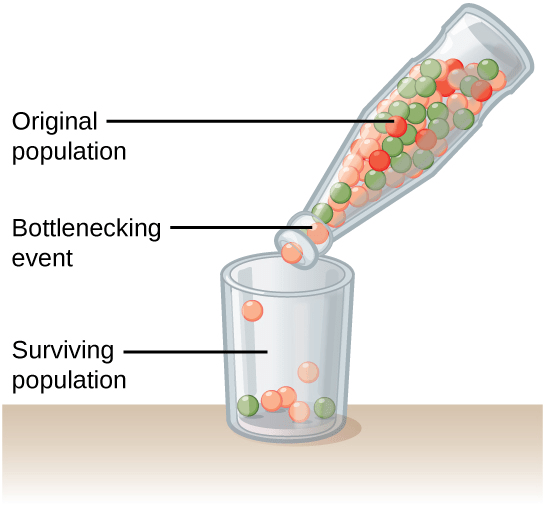
Gene flow
Gene flow is also known as gene migration; it is defined as the transmission of alleles through populations. Gene flow means that new generations are produced carrying a certain allele that has been transmitted from a donor population to a recipient population. Both having different frequencies of this allele. For example, pollen may be spread to distant places by wind carrying alleles from a population with high allele frequency to another population with low allele frequency. However, the largest unit within which gene flow can readily occur is a species.
Gene flow is a very important mechanism that maintains genetic diversity among populations and contributes to the evolutionary process by migration of genes between two populations having different allele frequencies. This factor can produce new alleles or rearrangements of chromosomes when the new allele was not previously found in the recipient population. The effects of gene flow include increasing the genetic diversity and the introduction of new alleles among populations.
Natural selection
Natural selection is a process by which the gene pool of the population changes due to the reproduction of individuals that can resist environmental changes. It is an important method of population adaptation to environmental conditions during evolution. Individuals can resist environmental factors in the short term by physiological methods. However, long-term resistance requires changing the population’s genetic composition to survive.
Natural selection is the transfer of useful alleles to the following generation leading to enhanced adaptability. Natural selection supports more adapted organisms while destroying less adapted individuals. Therefore, genetic material changes along with natural selection are the basis of evolution among species. The elimination of the less adapting alleles in the population eliminates the more susceptible organisms that cannot tolerate environmental changes. Consequently, natural selection influences the frequency of alleles in a population by affecting the contribution of individuals in next generations changing frequencies of genes.
Sexual selection results from either the direct competition for fertilization among males or sperms (same-sex members) or from the attraction of different sexes to each other. Sexual selection affects genetic diversity levels and accordingly it affects genetic evolution. Genetic diversity present among generations depends on the genes transmitted from both males and females across generations to keep genetic diversity.
Conservation of Genetic Diversity
Genetic diversity is facing many threats. Therefore, the international community is committed to maintaining all levels of biodiversity, including species genetic diversity. Conservation genetics tends to maintain genetic diversity in different levels and to assess and monitor the conservation plan in populations. They are mainly concerned with the conservation of different elements affecting genetic diversity such as genetic variation patterns, species, populations, and genotypes. Genetic diversity preservation maintains the reproductive capacity in the short term while it maintains the ability of species for adaptation and evolution in the long term.
One of the main goals of conservation genetics is to maintain genetic variation among endangered and rare species. The process of conservation of genetic diversity is mediated by three components: (1) defining the aim of conservation, (2) knowledge of populations’ genetic diversity, and (3) applying methods for conservation. The most convenient strategy for gene conservation for a species depends on the local attributes, the genetic structure of the population, and the geographic range size. For example, the genetic diversity of forest trees is maintained by the following methods: by growing populations in their original habitat, by storing germplasm in a cold environment, or by planting trees in different places outside their origin.
Conservation of genetic diversity is the same for all living organisms; however, different methods are applied depending on the goal of conservation, distribution of the conservation object, and biological nature. Therefore, the knowledge of variations among and within populations is essential to get information for the management of conservation of different populations.
Try to answer the quiz below and see what you have learned so far about genetic diversity.
References
- Ellegren, H., & Galtier, N. (2016). Determinants of genetic diversity. Nature Reviews Genetics, 17(7), 422-433.
- Manoel Galetti, P. (2018). Conservation Genetics. Reference Module in Biomedical Sciences.
- Nevo, E. (2001). Encyclopedia of Biodiversity || Genetic Diversity 662–677.
- Nonić, M., Milovanović, J., & Šijačić-Nikolić, M. (2020). CONSERVATION OF BIODIVERSITY AND FOREST GENETIC RESOURCES IN SERBIA. National parks, 4, 1.
- Swingland, I. R. (2001). Biodiversity, definition of. Encyclopedia of biodiversity, 1, 377-391.
- Wein, T., & Dagan, T. (2019). The effect of population bottleneck size and selective regime on genetic diversity and evolvability in bacteria. Genome biology and evolution, 11(11), 3283-3290.
©BiologyOnline.com. Content provided and moderated by Biology Online Editors.


